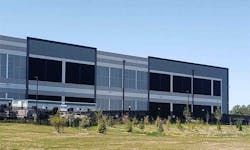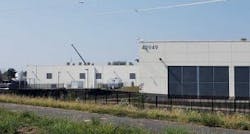AWS Plans Massive Expansion of its Northern Virginia Cloud Cluster
Amazon Web Services continues to expand its massive cloud cluster in Northern Virginia, where it operates more than 50 data centers. It’s the largest single concentration of corporate data center infrastructure on earth, housing the AWS US-East cloud region.
It could get much bigger soon. Amazon is seeking to build a massive data center campus just south of Dulles Airport, which could add up to 2.5 million square feet of cloud capacity. It’s one of at least five potential AWS data center projects being developed in Northern Virginia, including multiple sites in the new cloud corridor by the airport.
The expansion builds on Amazon’s massive US-East region, where it maintains six availability zones, more than in any other location. AWS has deployed 4 million square feet of data center space in Northern Virginia with developer Corporate Office Properties Trust (COPT), and will add another 1.2 million square feet through COPT projects in 2020 and the first quarter of 2021.
Google and Microsoft are also adding cloud capacity in Northern Virginia, which is experiencing a huge burst in data center development during 2020. This is due in part to the impact of the COVID-19 pandemic, which Amazon executives say may accelerate cloud adoption in some sectors, as companies look to “migrate fast” to create a nimbler IT infrastructure that can adjust to new ways of doing business.
That includes state and local governments. At the recent AWS Public Sector Summit, AWS revealed that nine U.S. Federal agencies and 14 states moved operations to the Amazon cloud during the early weeks of the pandemic, rapidly retooling to scale their services.
“The COVID-19 crisis shows just how fast organizations can move when missions need to drive decision making,” said Theresa Carlson, VP for Worldwide Public Sector at Amazon in the summit keynote. “We’ve seen public sector organizations move so fast during this time. In fact, we’ve seen more innovation in the past two to three months than we’ve seen over the last two years. These migrations happened under exceptional circumstances, and they offer a playbook for the new normal.”
The ‘Perfect Place’ to Build
That new normal will require more data centers. That’s why Amazon and its development partners have been buying land for future development (“land banking”), including parcels adjacent to Dulles Airport.
The largest of these is a 100-acre site in Chantilly known as the H&M Property, which an Amazon affiliate acquired last year for $73 million. The property sits between two existing AWS data center campuses, and would allow the cloud giant to create a mega-cluster of server farms tied together by low-latency fiber connections. AWS submitted plans to build up to 1.7 million square feet of data center space, which would probably make the H&M site the largest single Amazon cloud campus.
Loudoun County planning officials came back to the company with a surprising request: Think bigger.
“This is the perfect place for a data center,” said planning commission member Jeff Salmon, who represents the Dulles District, in a meeting last week. “We love data centers. We really do. One of the challenges has often been where they’re located.”
Data center design and location has been a hot topic in Loudoun County, where some members of the community have been critical of the appearance of some of the 100-plus data centers that shape the visual landscape, particularly in the Data Center Alley cloud cluster in Ashburn. Local tensions focus on noise in residential neighborhoods and uninspired designs lining major roads.
Since the H&M site is currently used for mineral extraction and other industrial uses, a data center would preserve land, create less traffic, and generate far more tax revenue for the county. The buildings would not be visible from major roads.
So county officials suggested that AWS apply for a denser floor-to-area ratio (FAR) of 0.6, which would allow for up to 2.5 million square feet of data center space.
The revised plan sailed through the Planning Commission last week by a 9-0 vote, and appears poised for approval in an upcoming Board of Supervisors meeting.
“We would love to have as much data center space in this particular location as possible,” said Salmon. “It’s far away from the major roads. It’s not near residences. It’s not near retail. It’s near a concrete plant, a telecommunications monopole and several contractor establishments for mowing your lawn.”
Multiple Projects to Add Cloud Capacity
AWS hasn’t yet decided whether it will build out the full 2.5 million square feet, which would require multi-story buildings. After years of using a standard one-story design, AWS has recently joined the growing number of developers building multi-story data centers.
That includes a new project just across the road from the H&M site. where Amazon has proposed building a two-story, 245,000 square foot data center on a 9-acre strip of land alongside an existing three-building AWS cloud campus.
In addition to those two sites, there are three other active properties tied to AWS.
- Amazon has seeking fast-track approval for the first of three data centers on a 90-acre property in South Riding, west of an existing AWS three-building campus in Arcola. The site plan calls for up to 900,000 square feet of data center space.
- COPT is seeking to develop two data centers for AWS in Waterside, a mixed-use project near the intersection of Routes 28 and 606 north of the airport in Sterling, with preliminary site plans that include two data centers.
- An Amazon affiliate has paid $54 million to acquire 2.4 million square feet in Herndon, East of Dulles Airport. The site, known as the Perspecta Property, houses a large office complex. Local media report that the site may be razed to make space for AWS data centers.
Amazon Web Services data centers in Loudoun County, Virginia. (Photo: Rich Miller)
These projects are consistent with Amazon’s steady effort to provision more capacity for its fast-growing AWS cloud operation, which had $10.8 billion in revenue in the second quarter of 2020. AWS and its development partners are constantly acquiring land and building data centers to ensure that the company doesn’t run out of server space in Northern Virginia, which is unique in its connectivity, serving as the global crossroads for the Internet. As the cloud grows, having servers in the region has become the table stakes for companies with ambitions in cloud computing.
This year, for example, COPT has deployed a new data center every three months for AWS, including a 230,000 SF facility in the first quarter and a 216,000 SF building in the second quarter. The developer is scheduled to deliver a 274,000 SF data center for AWS this quarter, and a 230,000 SF building in the first quarter of 2021.
Airports As Data Center Magnets
The new AWS projects contribute to an epic expansion of the new “Cloud Corridor” along Route 50 in South Loudoun, where land prices have been rising as data center developers lock down prime development parcels.
Development in Northern Virginia has historically been focused on Data Center Alley, but there is a dwindling supply of development parcels in Ashburn, “There’s some infill pieces in Data Center Alley,” said Buddy Rizer, the Executive Director of Economic Development for Loudoun County. “But apart from redevelopment, there’s not many sites left in Ashburn. I think that the area near Route 50, and Route 606 (near Dulles) has a lot of activity right now.”
In the early days of the data center industry, site selection managers sometimes sought to avoid locating facilities near airports or in busy flight paths. Concern has faded over the years, offset by the lack of incidents and the rich infrastructure found near many airports, which often eases the addition of new utility capacity for data centers.
Dulles isn’t the only airport with new data centers as neighbors. The Santa Clara data center district is adjacent to Mineta Airport in San Jose, and the Suburban Chicago data hub in Elk Grove Village is next door to runways at O’Hare airport.
About the Author



